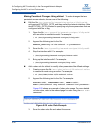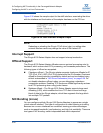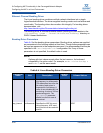
6–Configuring NIC Functionality in the Converged Network Adapter
Configuring the NIC in a Linux Environment
FE0254601-00 A 6-41
Switch Independent Bonding
Switch independent teaming is implemented entirely at the adapter-host level.
The Ethernet switch that is connected to the adapter is unaware of the team, and
no switch involvement is required for team operation. QLogic 8100 Series
Adapters support switch independent teams only by using a specialized QLogic
NIC teaming driver and the QConvergeConsole CLI for Microsoft Windows
environments.
Switch independent bonding functions in one of the following modes:
Failover mode allows only one active team member at any time. When the
active team member is not available, due to a link down or a hardware fault,
the automatic failover mechanism selects another healthy team member to
be the active member, and traffic continues uninterrupted.
Load balanced mode has all the capabilities of failover mode, except all
team members remain active and are able to distribute the transmit side of
TCP/IP traffic between them.
Switch Dependent Bonding
Switch dependent bonding implements the adapter bonding function with the
bonding capabilities of the switch. There are two switch dependent bonding
modes:
Static bonding (or generic trunking) mode is also known as IEEE 802.3ad
Link Aggregation static mode and requires configuration at both ends of the
link (server adapter port and switch). In this teaming mode, the adapter NIC
teaming driver controls only load balancing and failover for outgoing traffic,
while incoming traffic is controlled by the switch.
Dynamic bonding mode using aggregation control protocol (LACP) is similar
to static teaming, except IEEE 802.3ad LACP is used between the adapter
port and the switch to negotiate with the adapter ports that make up the
team. In this mode, LACP controls the addition and removal of physical links
for the link aggregation, so that no frames are lost or duplicated in the
process.
Bonding Prerequisites
Before you configure the bonding driver, you must download and install the
following:
Ethernet channel bonding driver (bonding driver)
ifenslave utility
For RHEL 5 based-Linux distributions, both the bonding driver and the
ifenslave utility are available by default.


















